Activation of Rhoa and ROCK are essential for detachment of migrating leukocytes
- PMID: 11452009
- PMCID: PMC55668
- DOI: 10.1091/mbc.12.7.2137
Activation of Rhoa and ROCK are essential for detachment of migrating leukocytes
Abstract
Detachment of the rear of the cell from its substratum is an important aspect of locomotion. The signaling routes involved in this adhesive release are largely unknown. One of the few candidate proteins to play a role is RhoA, because activation of RhoA in many cell types leads to contraction, a mechanism probably involved in detachment. To study the role of RhoA in detachment regulation, we analyzed several subsets of expert migratory leukocytes by video microscopy. In contrast to fast-migrating neutrophils, eosinophils do not detach the rear of the cell unless stimulated with serum. When measuring the amount of active RhoA, with the use of a GST-Rhotekin pulldown assay, we found that serum is an excellent activator of RhoA in granulocytes. Inhibition of RhoA or one of Rho's target proteins, the kinase ROCK, in neutrophils leads to the phenotype seen in eosinophils: the rear of the cell is firmly attached to the substratum, whereas the cell body is highly motile. ROCK-inhibition leads to impaired migration of granulocytes in filters, on glass, and through endothelial monolayers. Also, the ROCK signaling pathway is involved in changes of integrin-mediated adhesion. Eosinophil transduction by a tat-fusion construct containing active RhoA resulted in detachment stimulation in the presence of chemoattractant. From these results we conclude that activation of the RhoA-ROCK pathway is essential for detachment of migratory leukocytes.
Figures
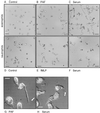

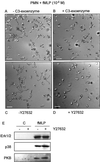
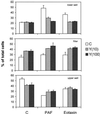
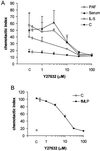
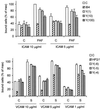

Similar articles
-
Requirement for RhoA kinase activation in leukocyte de-adhesion.J Immunol. 2002 Sep 1;169(5):2330-6. doi: 10.4049/jimmunol.169.5.2330. J Immunol. 2002. PMID: 12193698
-
The functional role of rho and rho-associated coiled-coil forming protein kinase in eotaxin signaling of eosinophils.J Immunol. 2001 Oct 15;167(8):4609-15. doi: 10.4049/jimmunol.167.8.4609. J Immunol. 2001. PMID: 11591790
-
RhoA activation promotes transendothelial migration of monocytes via ROCK.J Leukoc Biol. 2004 Mar;75(3):523-8. doi: 10.1189/jlb.0203054. Epub 2003 Nov 21. J Leukoc Biol. 2004. PMID: 14634067
-
Small guanine nucleotide-binding protein Rho and myocardial function.Acta Pharmacol Sin. 2005 Mar;26(3):279-85. doi: 10.1111/j.1745-7254.2005.00059.x. Acta Pharmacol Sin. 2005. PMID: 15715922 Review.
-
Role of RhoA-ROCK signaling in Parkinson's disease.Eur J Pharmacol. 2021 Mar 5;894:173815. doi: 10.1016/j.ejphar.2020.173815. Epub 2020 Dec 17. Eur J Pharmacol. 2021. PMID: 33345850 Review.
Cited by
-
Localized RhoA GTPase activity regulates dynamics of endothelial monolayer integrity.Cardiovasc Res. 2013 Aug 1;99(3):471-82. doi: 10.1093/cvr/cvt075. Epub 2013 Mar 27. Cardiovasc Res. 2013. PMID: 23536606 Free PMC article.
-
The UDP-sugar-sensing P2Y(14) receptor promotes Rho-mediated signaling and chemotaxis in human neutrophils.Am J Physiol Cell Physiol. 2012 Sep 1;303(5):C490-8. doi: 10.1152/ajpcell.00138.2012. Epub 2012 Jun 6. Am J Physiol Cell Physiol. 2012. PMID: 22673622 Free PMC article.
-
Integrative functional genomic analysis identifies epigenetically regulated fibromodulin as an essential gene for glioma cell migration.Oncogene. 2017 Jan 5;36(1):71-83. doi: 10.1038/onc.2016.176. Epub 2016 May 23. Oncogene. 2017. PMID: 27212030
-
Shear stress-induced endothelial cell polarization is mediated by Rho and Rac but not Cdc42 or PI 3-kinases.J Cell Biol. 2003 Apr 28;161(2):429-39. doi: 10.1083/jcb.200210135. J Cell Biol. 2003. PMID: 12719476 Free PMC article.
-
Localized RhoA activation as a requirement for the induction of membrane ruffling.Mol Biol Cell. 2005 Sep;16(9):4294-303. doi: 10.1091/mbc.e04-12-1076. Epub 2005 Jun 29. Mol Biol Cell. 2005. PMID: 15987744 Free PMC article.
References
-
- Amano M, Ito M, Kimura K, Fukata Y, Chihara K, Nakano T, Matsuura Y, Kaibuchi K. Phosphorylation and activation of myosin by Rho-associated kinase (Rho-kinase) J Biol Chem. 1996;271:20246–20249. - PubMed
-
- Aspenström P. Effectors for the Rho GTPases. Curr Opin Cell Biol. 1999;11:95–102. - PubMed
-
- Essler M, Amano M, Kruse HJ, Kaibuchi K, Weber PC, Aepfelbacher M. Thrombin inactivates myosin light chain phosphatase via Rho and its target Rho kinase in human endothelial cells. J Biol Chem. 1998;273:21867–21874. - PubMed
Publication types
MeSH terms
Substances
Grants and funding
LinkOut - more resources
Full Text Sources
Other Literature Sources
Research Materials

